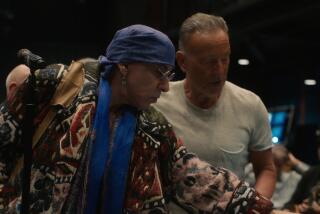Seeing the shadow of the past
One of the more rarefied of modern movie magicians, Canadian director Guy Maddin passed through Sundance Film Festival in January to present his feature “The Saddest Music in the World.” Now 44, Maddin, who lives and works out of his native Winnipeg, makes richly stylized, weirdly touching, often deviously funny movies filled with smoke and mirrors and allusions to cinematic fever dreams long past. (Among his influences: Luis Bunuel, Josef Von Sternberg and Frank Borzage.)
Long a cult favorite, Maddin stands ready to reach his largest audience yet with “The Saddest Music in the World,” about a contest to determine, yes, the saddest music in the world. Filled with melancholy melodies, faces as pure as that of Lillian Gish and narrative fillips as perverse as those of David Lynch, the film stars Isabella Rossellini, who, just so you know you’re watching a Guy Maddin marvel, wears glass legs filled with sloshing beer. Here’s a sample of Maddin unplugged.
When did you develop your visual style?
I had someone shooting my very first movie for me, but he failed to show up on the second day. I went over to his house and he wouldn’t get out of his bed -- he was very depressed -- so he taught me to work the camera and light meter. It took five minutes. I was shocked -- I didn’t know how to work a projector or a remote control. Then, while lighting [the film] -- you’re supposed to do a standard three-light setup -- I learned that made for three nose shadows on everyone’s face. I unplugged the other two lights and suddenly learned that the shadow was the best prop, that it cast all sorts of atmospheric mystery. So, about halfway through I’d already developed a very high-contrast, film noir atmosphere. I didn’t know you were supposed to clean the camera -- there was all sorts of scratches and dirt [on the lens], and because your head quickly becomes filled if you’re concerned with continuity and I noticed that Bunuel’s greatest delights were in jerking continuity around, I ignored continuity. By the end of my first movie I had a style, an unwritten manifesto which I’ve more or less kind of obeyed every since.
I take it that you didn’t set out to be a cult director?
No, I always wanted to have an audience. I had made these fiercely independent movies of my own, but a lot of times -- how to put it? So much of what was important wasn’t just the atmosphere, it was the stories, and so many people were telling me how much they loved my movies because they were non-narrative. It was a disappointment. I hated to tell them that what I really wanted to do was to tell a story that knocked their socks off, plus looked beautiful with strange photography and was unpredictable. I really wanted to work on getting the stories clear. I’ve learned to have test screenings, as hurtful as the answers may feel. It’s my own version of the mass Hollywood preview screenings -- but it’s just with select people, just to see how it’s playing.
Your films feel like lost movies from a lost world.
I hate it when things are gone, gone, lost forever. I grew up youngest of four children, but I was by far the youngest. I guess I was an afterthought or an accident. And I was left alone by parents tired out by years of parenting. I was brought home the same day as the television -- we were both put on the floor together -- they were the happiest years of my life. TV wasn’t on all the time, so I would look through photo albums of when my parents were younger and more beautiful, when my siblings were young. Everyone seemed to have so much energy. They were all packed into station wagons -- there are photographs of them at the Grand Canyon, at Bemidji [Minn.] with Paul Bunyan, in California. I just delighted in seeing my toys -- which had their heads chewed off by the long-dead dog I could only visit in photographs -- finding them with their heads intact.
I had these photo albums to look through, and they were always in black-and-white; it was the past, when times were better. It was that reductive, I think, for me at the time. And meanwhile I just put in day after day after day in front of the TV. Making these one-to-one correlations between past and present and realizing that the arrow’s always pointing toward the past and that the whole process seemed to point my nose in that direction -- that was how I sucked the nectars out of each day from 8 in the morning till bedtime.
Do you ever watch new movies?
I kind of liked “Terminator 3” last summer, and I was just in the right mood for “Charlie’s Angels: Full Throttle,” though I’m sure it won’t stand up.
More to Read
Only good movies
Get the Indie Focus newsletter, Mark Olsen's weekly guide to the world of cinema.
You may occasionally receive promotional content from the Los Angeles Times.










